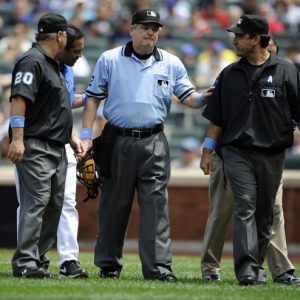Handicapping MLB Umpires: Strike Zones
by Aaron Smith - 4/8/2010
![]()

Baseball is here, and it’s time to start looking for an edge on the rest of the sports betting world. If you are serious about making cash by betting on baseball, then I strongly advise you to get to know your umpires. The fact of the matter is no single person has a larger effect on any sports game than the home plate umpire in the game of baseball. Think about how they control the strike zone, which shapes the way a pitcher has to pitch and the batter has to protect the plate.
Since knowing an umpire’s strike zone is so vital, let’s take a closer look at which umpires pinch the zone and which umpires are particularly generous with their strike calls.
First, we’ll take a look at the umpires that can make it extremely tough on a pitcher to locate the zone, because there just isn’t much of a zone at all to find. Obviously, these umpires tend to have higher scoring games and more games go over the posted total than those who would call more strikes. The umpires on this list are also frequently a part of arguments from the dugout or the mound about their lack of a strike zone.
Keep in mind, every pitch that is fouled off, or put in play is considered a strike as well in these statistics.
- Jerry Crawford - If this name sounds familiar it’s probably because Jerry’s brother (Joe) is a lead official in the National Basketball Association. Jerry is consistently the toughest umpire on pitchers. In 2008, Crawford called just 60.8 percent of pitches a strike. Last season, he called only 60.7 percent of pitches a strike, and there were almost nine walks per game when he was behind the dish.
- Paul Schreiber - Schreiber actually called the fewest strikes of any umpire in 2008 at just 60.3 percent. In 2009, Schreiber called 61.6 percent of pitches a strike. Almost 10 runs per game have been scored in both of those years when he is behind home plate.
- Tim McClelland - McClelland has been umpiring for quite some time now, and he has been consistently a friend of ‘over’ bettors. In 2008, he called 61.8 percent of pitches a strike. In 2009, he had the lowest percentage of strikes at just 60.5 percent.
- Randy Marsh - Marsh has a history of having the smallest amount of strikeouts per game of just about any umpire at about 12 per game. Obviously, this means he is hesitant to ring up the batter. In 2008, Marsh called 61.7 percent of pitches a strike. In 2009, 61.9 percent of pitches were called a strike.
- Gerry Davis - Davis, like McClelland, has been around quite a while and tends to pinch the zone. In 2008, he called 61.8 percent of pitches a strike. In 2009, 61.5 percent of pitches were called strikes.
On the other end of the spectrum, there are some umpires who are quick to ring up the hitter and will move the game along with their constant strike calls. It’s generally the batters who have a beef with these guys!
- Doug Eddings - Eddings has averaged about 14 strikeouts per game in the last two seasons. In 2008, he called an astounding 64.1 percent of pitches a strike. In 2009, he called 63.2 percent of pitches a strike.
- Brian Gorman - Gorman actually called the most strikes of anyone in 2008, at 64.2 percent. In 2009, he called 63.3 percent of pitches a strike. The most impressive statistic is that he has issued less than six walks per game in both of the last two seasons.
- Laz Diaz - Diaz is another umpire who has consistently made the hitters swing away at the plate. In 2008, he called 64.0 percent of pitches a strike. Last season, 63.4 percent of pitches were called strikes.
- Brian Runge - It shouldn’t come as a surprise that there were 7.9 runs scored per game when Runge was behind the plate last season. He has been as consistent as they come in calling strikes, with 63.8 percent of pitches going for a strike in 2008 and 63.7 percent of them a strike in 2009.
- Phil Cuzzi - Cuzzi had an impressive record of 22-12 toward the ‘under’ in 2009. In 2008, he called 64.2 percent of pitches a strike. In 2009, Cuzzi called 63.5 percent of the pitches strikes. Another telling statistic is the batting average of hitters when Cuzzi is behind the plate. In 2008 hitters averaged just .256 and in 2009 they averaged a meager .255.
There really is a huge benefit to knowing who is behind home plate when you make a wager on a baseball game. Add this important piece of information on umpires and their strike zones to your arsenal to use when you make your next wager!
Most Recent Baseball Handicapping
- 2025 MLB Cy Young Award Odds and Predictions for AL and NL
- San Francisco Giants at New York Yankees Weekend Series Predictions with Odds and Analysis
- 2025 MLB Season Win Totals Predictions
- 3-for-1 MLB Picks Special
- 2025 San Francisco Giants Predictions with World Series Odds and Season Win Total Picks
- 2025 San Diego Padres Predictions with World Series Odds and Season Win Total Picks
- 2025 Colorado Rockies Predictions with World Series Odds and Season Win Total Picks
- 2025 Arizona Diamondbacks Predictions with World Series Odds and Season Win Total Picks
- 2025 Los Angeles Dodgers Predictions with World Series Odds and Season Win Total Picks
- 2025 St. Louis Cardinals Predictions with World Series Odds and Season Win Total Picks
